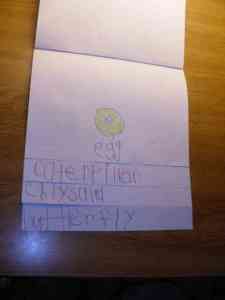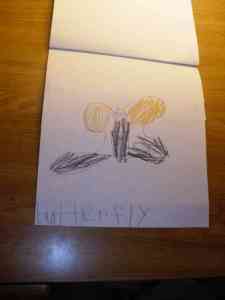As we’re wrapping up our study on butterflies, I wanted to post a couple of ways we integrated writing into our unit. I have been SO proud of his attitude while writing lately.
1. Butterfly Life Cycle
I read Becoming Butterflies by Anne Rockwell. This book tells about the life cycle of Monarch butterflies and we compared it to what had happened with our painted lady butterflies.
He worked the butterfly life cycle puzzle from Lakeshore. This served as a quick review. I believe it is discontinued now, but I found the set at yard sale recently for $2.
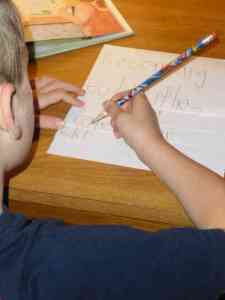 I folded over pieces of paper and created a flip chart to show how a caterpillar turns into a butterfly. He used pictures and words from the book to help him draw and write the words. Something I noticed is that chrysalid and chrysalis seem to be interchangeable. Maybe I’m wrong…and if I am, please correct me!
I folded over pieces of paper and created a flip chart to show how a caterpillar turns into a butterfly. He used pictures and words from the book to help him draw and write the words. Something I noticed is that chrysalid and chrysalis seem to be interchangeable. Maybe I’m wrong…and if I am, please correct me!
On the top page, he wrote Becoming Butterflies.
Here are a couple of his inside pages:
This flip chart concept could be adapted and used with many different content areas.
Just a few that pop in my mind right away are:
- retelling a story in order
- helping a child understand where they live: city, state, country, continent would go on the pages and the child would draw pictures of those things on the inside flaps
- writing math problems: for example, 4+5 could be written and when it’s flipped open, the child writes the answer and maybe draws pictures or writes words to show how she got the answer
2. What Did You Learn?
I read It’s a Butterfly’s Life by Irene Kelly. This is VERY interesting book. For example, did you know that a caterpillar’s poop is called frass? Some caterpillars can even “shoot” their frass up to 3 feet (we pulled out a yard stick to see just how far that was)! There were parts of the book that were WAY over his head, so I paraphrased or skipped those.
Before reading, I told ALuv that this book contained very interesting and even gross facts about butterflies. This really engaged him, as he wanted to get to the gross parts.
During reading, I kept commenting, “Wow! I didn’t know that before!” or “That’s so cool!” He made comments as well.
After reading, I asked him what facts he remembered the most. We engaged in dialogue about this, as I shared mine. Once he established his favorite, I asked him to draw a picture showing it. I walked away as he worked, so as not to “hover” (as my husband calls it).
This is what he drew:
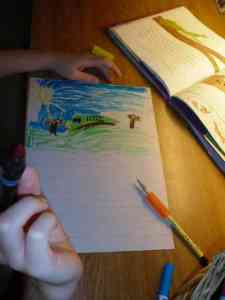 A green caterpillar with large eye spots.
A green caterpillar with large eye spots.
Once he had his picture drawn, I asked him to tell me about it. I helped him narrow down the sentence he wanted to write and I set him free to write it. I listened. No whining…no crying…not an utterance of “But I can’t!”. After a couple minutes of silence, I was intrigued. I simply walked by to see what was happening. He had already written two words: The caterpillar. He had used the flip chart I mentioned above to spell caterpillar! I was so proud!!
He used the Word Wall to spell several other sight words. A few times, he did ask for help. When he did, I modeled how to stretch out the words. He said the words, too and wrote down the sounds he heard. Stretching out words and writing down the phonemes is a great way to further develop a child’s phonemic awareness; a necessary skill for reading!
This is the final work:
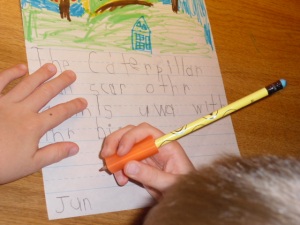 The Caterpillar can scar othr animls uwa with thr big is.
The Caterpillar can scar othr animls uwa with thr big is.
(The caterpillar can scare other animals away with their big eyes.)
This reading mama’s favorite was UWA for away…brilliant! Okay, so I am aware that he has a capital C at the beginning of caterpillar and that this “fact” isn’t entirely true…they’re really eye spots, but who cares?!?! I could not stop praising him for his good attitude and hard work. His handwriting looks amazing! Just about a month ago, he didn’t even understand how to use the lines. Now, he can use them independently! Yay!
What do I think made such a big difference in a month’s time? I believe it all boils down to best teaching practices that work in any content area:
- Modeling: If you remember, when he wrote in his journal about our butterflies, I modeled “correct” letter formation on a lined dry erase board; which I found at Target in their $1 bin last year. He has also repeated the sentence strip handwriting activity; which gives him a good model with letter formation.
- Multiple Exposures: I bumped up my expectations with him. We write almost every day now.
- Meaningful Practice: Not worksheet after worksheet, but fun and authentic reasons for writing.
And…an old trick I had forgotten until recently: Let him draw his picture first. Drawing tends to be easier (and more fun) for kids at a young age and a less daunting place for them to start. Encourage them to fill their pictures with lots of details. When they’re done, ask them to describe their picture to you so they can verbalize their thoughts. They may even allow you to label their picture. Then, help them to figure out what they want to write down based off their picture.
